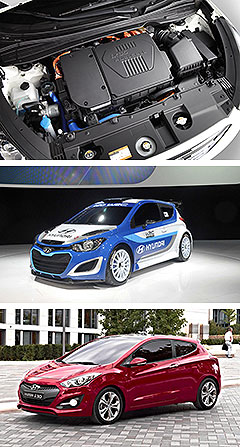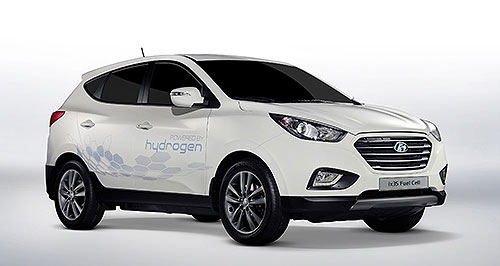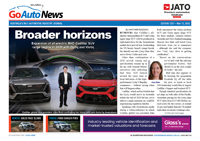Future models - Hyundai - ix35Paris show: Hyundai first with production fuel cell carNew nose: Hyundai's ix35 Fuel Cell has a nose treatment reminiscent of the new Santa Fe SUV, perhaps hinting at an upcoming facelift. Production hydrogen-powered ix35 Fuel Cell unveiled at Paris alongside i20 WRC car27 Sep 2012 SOUTH KOREA will beat Japan, Germany and the US to market with the world’s first series production vehicle to be powered by a hydrogen fuel cell – and it is based on the humble Hyundai ix35 compact SUV. The zero-emissions ix35 Fuel Cell publicly unveiled at the Paris motor show today will become available on a lease basis at the end of this year, and cities in Denmark and Sweden have already signed up to bring the vehicle into their municipal fleets. South Korea and California will also receive the ix35 Fuel Cell, but there are no plans to introduce it to Australia. Marking the ix35 Fuel Cell out from its internal combustion contemporaries is a new slatted grille and bumper design with re-shaped fog light apertures that bring the car’s styling closer to the new Santa Fe mid-size SUV and hint at a possible upcoming facelift. Hyundai has a target of building 1000 hydrogen-powered ix35s by 2015, after which it plans a production run of 10,000 units. The Hyundai’s fuel cell stack converts hydrogen into electricity, which powers the ix35’s electric motor to provide a 160km/h top speed, 0-100km/h in 12.5 seconds and a claimed driving range of 588km.  Left: ix35's fuel cell. Below: i20 WRC car and three-door i30. Left: ix35's fuel cell. Below: i20 WRC car and three-door i30.Only water is emitted from the tailpipe of the ix35 Fuel Cell, although a carbon footprint could be associated with the production, transport and storage of the highly volatile hydrogen gas used to fuel the vehicle. Hyundai says the cost of filling the tank of the ix35 Fuel Cell with 5.6kg of hydrogen works out at the equivalent of $A70 in Europe, translating to $A12.45 per 100 kilometres driven. However the cost of hydrogen fuel is currently set artificially, rather than by market forces, due to the tiny demand. Hyundai vice chairman and head of research and development, Woong Chul Yang, said the ix35 Fuel Cell means “zero-emissions cars are no longer a dream”. “Our ix35 Fuel Cell vehicle is here today, and ready for commercial use,” he said. Hyundai has been working on fuel cell technology for 14 years and invested “several hundred million Euros” on development at its research centre in the South Korean city of Mabuk, putting more than 3.2 million kilometres beneath the tyres of test vehicles across three continents. Earlier this year a prototype ix35 Fuel Cell travelled from Oslo in Norway to the Mediterranean principality of Monaco using only existing refuelling infrastructure, setting a record for hydrogen fuel range in the process. Hyundai says it is encouraged by government roadmaps and investment for building hydrogen infrastructure in Europe. The company has tried to keep the ix35 Fuel Cell’s driving experience as close to the standard car – but for the quieter electric drivetrain – and has ensured it can be built on a conventional assembly line at the Ulsan production facility in South Korea. Using ambient rather than compressed air to supply the fuel cell stack with oxygen, fitting a lithium-ion battery pack from the Sonata Hybrid that is charged through regenerative braking and equipping the driveline with an idle-stop system are said to improve efficiency, reduce noise and result in a better driving experience. Alongside the ix35 Fuel Cell at Paris is a rally version of the i20 light car, signalling Hyundai’s return to the World Rally Championship and its intention to establish an in-house WRC team in Europe. In line will current rules, the i20 WRC will run aerodynamic enhancements, all-wheel-drive, a turbocharged engine and sequential transmission. Hyundai first entered WRC in 1998, starting out in the F2 class before stepping up to the top class in 2000 with a rally car based on the three-door Accent competing until 2003. Also on the Hyundai stand at Paris is a sleek German-designed three-door version of the i30 small hatchback, but the company’s Australian outpost will be sticking with the five-door body style.  Read more17th of September 2012  Paris show: Hyundai’s bob-tailed i30 revealedEuro-styled three-door Hyundai i30 set for Paris reveal, but off the agenda for Oz13th of September 2012  First drive: Santa Fe completes Hyundai puzzleHyundai taps into booming large SUV sales in Australia with new Santa FeAll future models Alfa Romeo Alfa Romeo Abarth Abarth Alpine Alpine Alpina Alpina Audi Audi Aston Martin Aston Martin BMW BMW Bentley Bentley Chery Chery Brabham Brabham Chrysler Chrysler Chevrolet Chevrolet Cupra Cupra Citroen Citroen DS DS Dodge Dodge Fiat Fiat Ferrari Ferrari Foton Foton Ford Ford Great Wall Great Wall FPV FPV Haval Haval GWM GWM Honda Honda Holden Holden Hummer Hummer HSV HSV Infiniti Infiniti Hyundai Hyundai Jaguar Jaguar Isuzu Isuzu Kia Kia Jeep Jeep Land Rover Land Rover Lamborghini Lamborghini Lexus Lexus LDV LDV Mahindra Mahindra Lotus Lotus Mazda Mazda Maserati Maserati Mercedes-AMG Mercedes-AMG McLaren McLaren MG MG Mercedes-Benz Mercedes-Benz Mitsubishi Mitsubishi Mini Mini Opel Opel Nissan Nissan Peugeot Peugeot Pagani Pagani Proton Proton Porsche Porsche Renault Renault Ram Ram Rover Rover Rolls-Royce Rolls-Royce Skoda Skoda Saab Saab SsangYong SsangYong Smart Smart Suzuki Suzuki Subaru Subaru Toyota Toyota Tesla Tesla Volvo VolvoMotor industry news |
Click to shareHyundai modelsResearch Hyundai All future models Alfa Romeo Alfa Romeo Abarth Abarth Alpine Alpine Alpina Alpina Audi Audi Aston Martin Aston Martin BMW BMW Bentley Bentley Chery Chery Brabham Brabham Chrysler Chrysler Chevrolet Chevrolet Cupra Cupra Citroen Citroen DS DS Dodge Dodge Fiat Fiat Ferrari Ferrari Foton Foton Ford Ford Great Wall Great Wall FPV FPV Haval Haval GWM GWM Honda Honda Holden Holden Hummer Hummer HSV HSV Infiniti Infiniti Hyundai Hyundai Jaguar Jaguar Isuzu Isuzu Kia Kia Jeep Jeep Land Rover Land Rover Lamborghini Lamborghini Lexus Lexus LDV LDV Mahindra Mahindra Lotus Lotus Mazda Mazda Maserati Maserati Mercedes-AMG Mercedes-AMG McLaren McLaren MG MG Mercedes-Benz Mercedes-Benz Mitsubishi Mitsubishi Mini Mini Opel Opel Nissan Nissan Peugeot Peugeot Pagani Pagani Proton Proton Porsche Porsche Renault Renault Ram Ram Rover Rover Rolls-Royce Rolls-Royce Skoda Skoda Saab Saab SsangYong SsangYong Smart Smart Suzuki Suzuki Subaru Subaru Toyota Toyota Tesla Tesla Volvo VolvoMotor industry news |
















Facebook Twitter Instagram